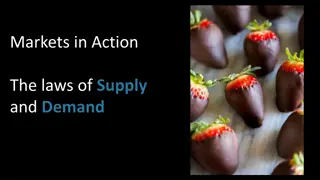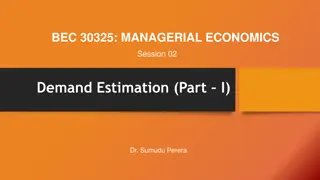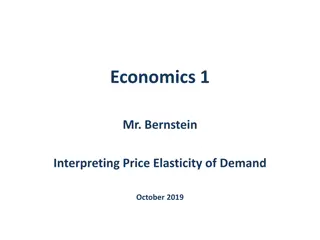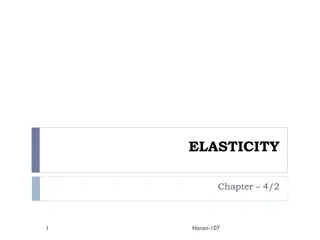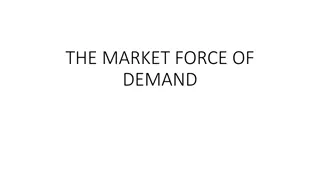Elasticity of Demand
Elasticity of Demand measures the responsiveness of quantity demanded to changes in market variables. It is categorized into three types: Price Elasticity of Demand (PED), Cross Elasticity of Demand (XED), and Income Elasticity of Demand (YED). Each type reflects different aspects of consumer behavior in response to various economic factors affecting demand.
Download Presentation

Please find below an Image/Link to download the presentation.
The content on the website is provided AS IS for your information and personal use only. It may not be sold, licensed, or shared on other websites without obtaining consent from the author.If you encounter any issues during the download, it is possible that the publisher has removed the file from their server.
You are allowed to download the files provided on this website for personal or commercial use, subject to the condition that they are used lawfully. All files are the property of their respective owners.
The content on the website is provided AS IS for your information and personal use only. It may not be sold, licensed, or shared on other websites without obtaining consent from the author.
E N D
Presentation Transcript
Elasticity of Demand and Elasticity of Demand and its Types its Types
Elasticity of Demand, or Demand Elasticity, is the measure of change in quantity demanded of a product in response to a change in any of the market variables, like price, income etc. It measures the shift in demand when other economic factors change. In other words, the elasticity of demand is the percentage change in quantity demanded divided by the percentage change in another economic variable. The demand for a commodity is affected by different economic variables: Price of the commodity Price of related commodities Income level of consumers
3 Types of Elasticity of Demand 3 Types of Elasticity of Demand On the basis of different factors affecting the quantity demanded for a product, elasticity of demand is categorized into mainly three categories: Price Elasticity of Demand (PED), Cross Elasticity of Demand (XED), and Income Elasticity of Demand (YED).
Price Elasticity of Demand Price Elasticity of Demand 1. Price Elasticity of Demand (PED) Any change in the price of a commodity, whether it s a decrease or increase, affects the quantity demanded for a product. For example, when there is a rise in the prices of ceiling fans, the quantity demanded goes down. This measure of responsiveness of quantity demanded when there is a change in price is termed as the Price Elasticity of Demand (PED). The mathematical formula given to calculate the Price Elasticity of Demand is: in Quantity Demanded / % Change in Price PED = % Change The result obtained from this formula determines the intensity of the effect of price change on the quantity demanded for a commodity.
Cross Elasticity of Demand Cross Elasticity of Demand 2. Cross Elasticity of Demand (XED) In a market where there is an oligopoly, multiple players compete. Thus, the quantity demanded for a product does not only depend on itself but rather, there is an effect even when prices of other goods change. Cross Elasticity of Demand, also represented as XED, is an economic concept that measures the sensitiveness of quantity demanded of one good (X) when there is a change in the price of another good (Y), and that s why it is also referred to as Cross-Price Elasticity of Demand. The formula given to calculate the Cross Elasticity of Demand is given as: XED = (% Change in Quantity Demanded for one good (X)) / (% Change in Price of another Good (Y)) The result obtained for a substitute good would always come out to be positive as whenever there is a rise in the price of a good, the demand for its substitute rises. Whereas, the result will be negative for a complementary good. These three types of Elasticity of Demand measure the sensitivity of quantity demanded to a change in the price of the good, income of consumers buying the good, and the price of another good.
Income Elasticity of Demand Income Elasticity of Demand 3. Income Elasticity of Demand (YED) The income levels of consumers play an important role in the quantity demanded for a product. This can be understood by looking at the difference in goods sold in the rural markets versus the goods sold in metro cities. The Income Elasticity of Demand, also represented by YED, refers to the sensitivity of quantity demanded for a certain good to a change in real income (the income earned by an individual after accounting for inflation) of the consumers who buy this good, keeping all other things constant. The formula given to calculate the Income Elasticity of Demand is given as: YED = % Change in Quantity Demanded/ % Change in Income The result obtained from this formula helps to determine whether a good is a necessity good or a luxury good.
5 other types of Elasticity of Demand 5 other types of Elasticity of Demand The effect of change in economic variables is not always the same on the quantity demanded for a product. The demand for a product can be elastic, inelastic, or unitary, depending on the rate of change in the demand with respect to the change in the price of a product. On the basis of the amount of fluctuation shown in the quantity demanded of a good, it is termed as elastic , inelastic , and unitary . An elastic demand is one that shows a larger fluctuation in the quantity demanded of a product, in response to even a little change in another economic variable. For example, if there is a hike of $0.5 in the price of a cup of coffee, there are very high chances of a steep decline in the quantity demanded. An inelastic demand is one that shows a very little fluctuation in the quantity demanded with respect to a change in another economic variable. An example of this can be petrol or diesel. Unitary elasticity is one in which the fluctuation in one variable and quantity demanded is equal.
1. Perfectly Elastic Demand 1. Perfectly Elastic Demand When there is a sharp rise or fall due to a change in the price of the commodity, it is said to be perfectly elastic demand. In perfectly elastic demand, even a small rise in price can result in a fall in demand of the good to zero, whereas a small decline in the price can increase the demand to infinity. However, perfectly elastic demand is a total theoretical concept and doesn t find a real application, unless the market is perfectly competitive and the product is homogenous. The degree of elasticity of demand helps to define the slope and shape of the demand curve. Therefore, we can determine the elasticity of demand by looking at the slope of the demand curve. A Flatter curve will represent a higher elastic demand. Thus, the slope of the demand curve for a perfectly elastic demand is horizontal.
2. Perfectly Inelastic Demand 2. Perfectly Inelastic Demand A perfectly inelastic demand is the one in which there is no change measured against a price change. Like perfectly elastic demand, the concept of perfectly inelastic is also a theoretical concept and doesn t find a practical application. However, the demand for necessity goods can be the closest example of perfectly inelastic demand. The numerical value obtained from the PED formula comes out as zero for a perfectly inelastic demand. The demand curve for a perfectly inelastic demand is a vertical line i.e. the slope of the curve is zero.
3. Relatively Elastic Demand 3. Relatively Elastic Demand Relatively elastic demand refers to the demand when the proportionate change in the demand is greater than the proportionate change in the price of the good. The numerical value of relatively elastic demand ranges between one to infinity. In relatively elastic demand, if the price of a good increases by 25% then the demand for the product will necessarily fall by more than 25%. Unlike the above mentioned types of demand, relatively elastic demand has a practical application as many goods respond in the same manner when there is a price change. The demand curve of relatively elastic demand is gradually sloping.
4. Relatively Inelastic Demand 4. Relatively Inelastic Demand In a relatively inelastic demand, the proportionate change in the quantity demanded for a product is always less than the proportionate change in the price. For example, if the price of a good goes down by 10%, the proportionate change in its demand will not go beyond 9.9..%, if it reaches 10% then it would be called unitary elastic demand. The numerical value of relatively inelastic demand always comes out as less than 1 and the demand curve is rapidly sloping for such type of demand.
5. Unitary Elastic Demand 5. Unitary Elastic Demand When the proportionate change in the quantity demanded for a product is equal to the proportionate change in the price of the commodity, it is said to be unitary elastic demand. The numerical value for unitary elastic demand is equal to 1. The demand curve for unitary elastic demand is represented as a rectangular hyperbola.
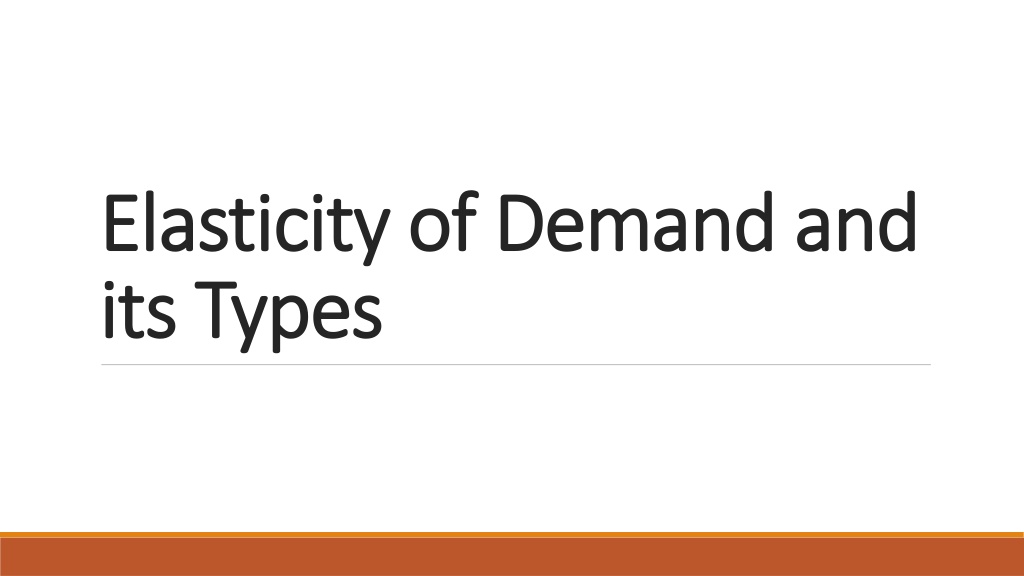
 undefined
undefined













